Raised garden beds can boost your gardening experience by maximizing space and making planting easier. With the right layout, you can optimize sunlight exposure and water drainage while adding a touch of style to your yard. Let’s explore some smart ideas for organizing your beds to create a productive and visually appealing garden.
Creating a Colorful Flower Border
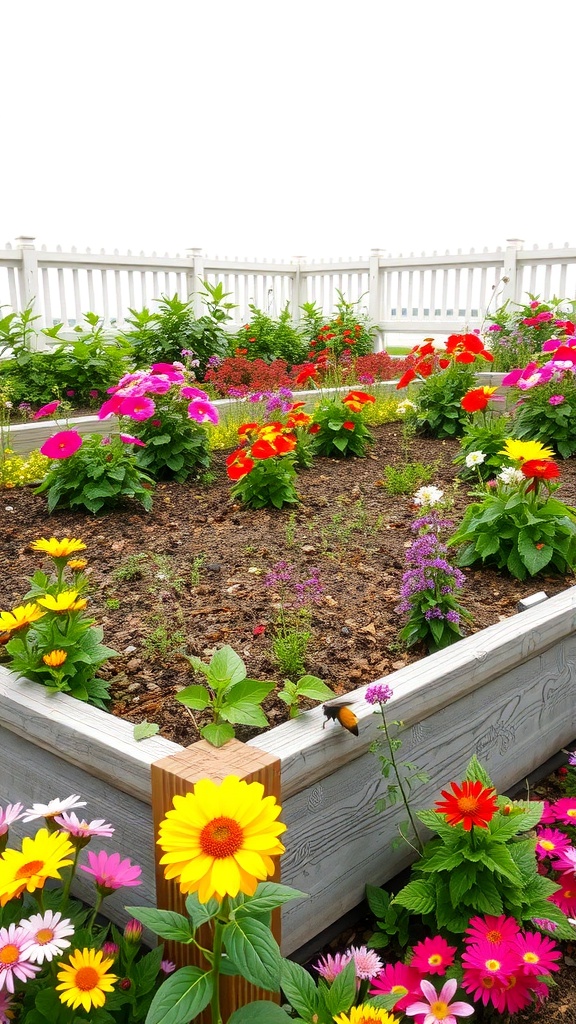
When designing your raised garden beds, adding a flower border can really brighten up the space. The image shows a vibrant arrangement of flowers surrounding a raised bed, creating a cheerful atmosphere.
In this layout, you can see a mix of colors and types of flowers. The bright yellows, reds, and pinks pop against the green foliage. This variety not only attracts pollinators but also adds visual interest.
Consider planting taller flowers at the back and shorter ones in front. This layering technique ensures that every bloom gets its moment in the sun. You can choose flowers that bloom at different times to keep the border lively throughout the growing season.
Don’t forget to think about the maintenance. Some flowers may require more care than others. Picking a mix of low-maintenance varieties can make your gardening experience more enjoyable.
Maximizing Sunlight Exposure
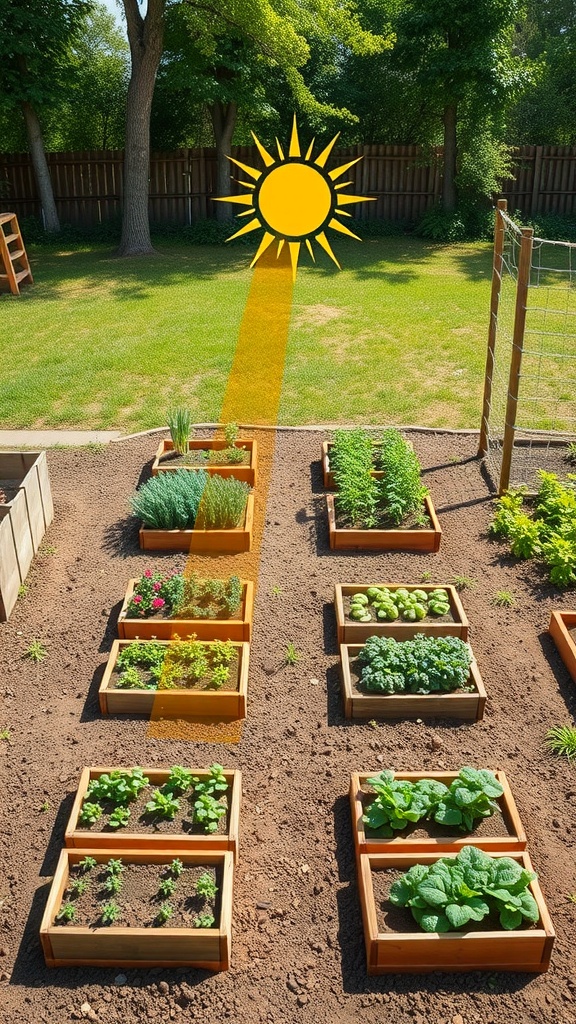
In this vibrant garden layout, the raised beds are arranged thoughtfully to capture sunlight. The sun’s rays shine down, highlighting the importance of positioning your plants for optimal growth.
Each bed is spaced out to allow sunlight to reach all sides. This setup ensures that taller plants do not shade the shorter ones, creating a balanced environment for growth. Herbs, vegetables, and flowers are all included, showcasing a variety of plants that thrive in sunny spots.
When planning your garden, consider the sun’s path throughout the day. Placing beds in a north-south orientation can help maximize exposure. This simple trick can lead to healthier plants and a more productive garden.
Don’t forget to monitor how shadows change with the seasons. Adjusting your layout can make a big difference in how much sunlight your plants receive. Happy gardening!
Incorporating Companion Planting
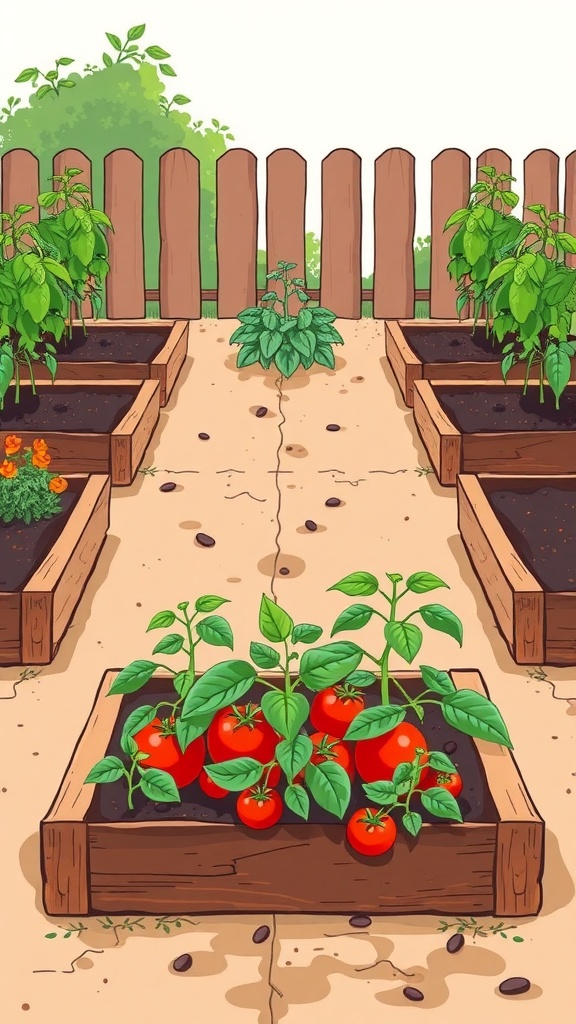
Companion planting is a fun way to boost your garden’s health and productivity. In the image, you can see raised garden beds filled with a variety of plants. Each plant has its own role, working together to create a thriving ecosystem.
For example, tomatoes are shown here, which pair well with basil. Basil can enhance the flavor of tomatoes while also repelling pests. This kind of planting not only maximizes space but also encourages a healthier garden.
Incorporating flowers like marigolds can attract beneficial insects, adding another layer of protection for your veggies. The layout in the image suggests a thoughtful arrangement, allowing each plant to benefit from its neighbors.
When planning your garden, think about which plants will thrive together. This approach can lead to a more vibrant and productive garden, making your efforts even more rewarding.
Utilizing Edging for Structure
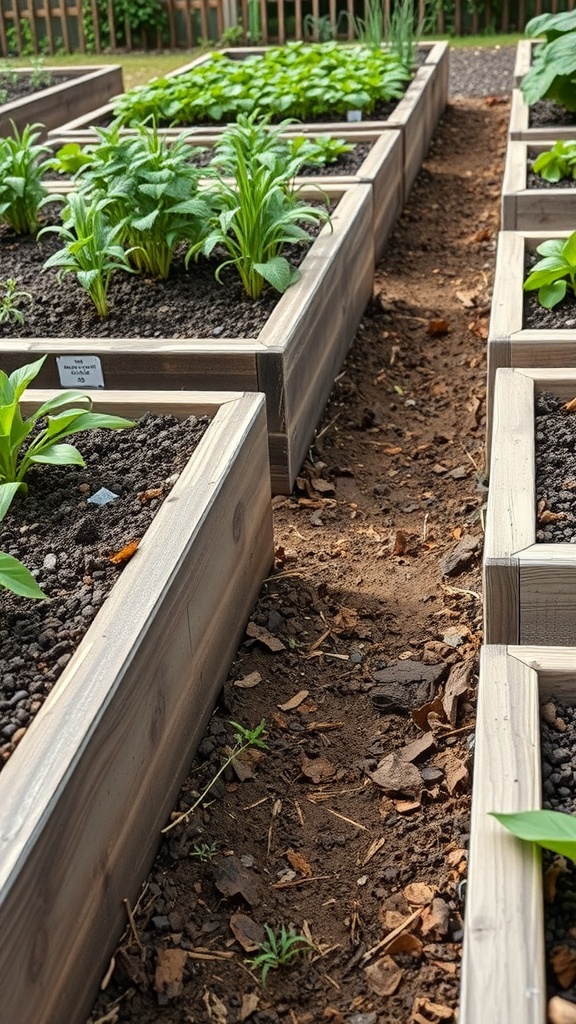
Raised garden beds are a fantastic way to grow your own plants while keeping everything organized. The image shows a neat layout of raised beds, surrounded by a well-defined path. This structure not only looks good but also makes gardening easier.
Using edging for your garden beds helps create a clear boundary. It keeps soil in place and prevents weeds from creeping in. The wooden frames in the image provide a sturdy structure that supports the plants while adding a rustic charm to the garden.
Paths between the beds, like the one shown, allow for easy access. You can walk comfortably without stepping into the soil. This design keeps your plants healthy and your garden tidy. Plus, it makes maintenance a breeze!
Consider adding mulch or gravel to the paths. This can help with drainage and reduce mud. With a little thought, your raised garden beds can be both functional and beautiful.
Choosing the Right Location for Your Beds
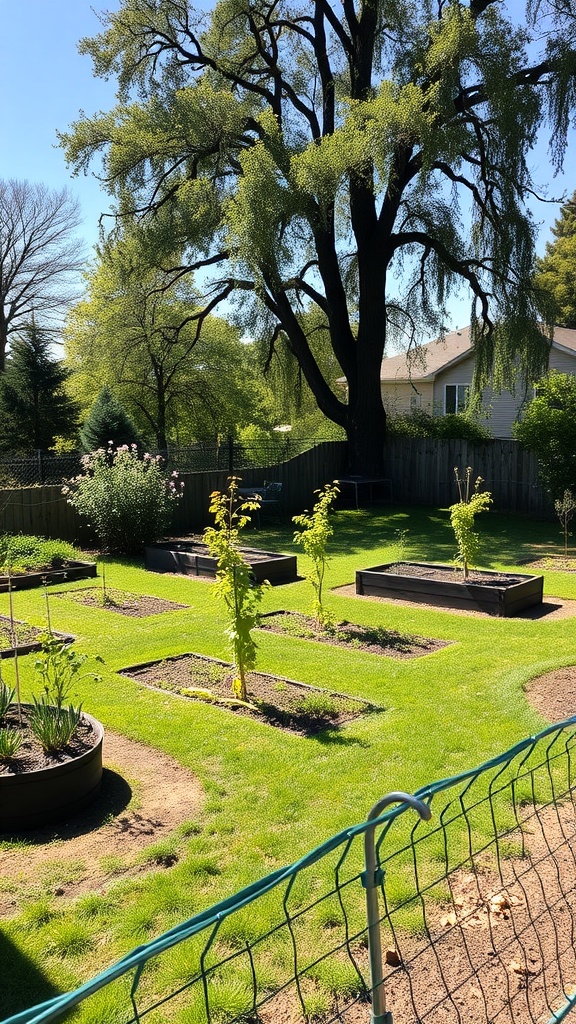
Finding the perfect spot for your raised garden beds is key to a thriving garden. The image shows a well-organized layout with beds positioned thoughtfully in a sunny area. This setup allows for maximum sunlight exposure, which is essential for plant growth.
Look for a location that gets at least six hours of sunlight each day. The beds in the image are placed in an open area, making them ideal for sun-loving plants. Avoid shaded spots, especially from large trees, as they can hinder growth.
Consider accessibility too. The layout here shows clear pathways between the beds, making it easy to reach each one for planting, watering, and harvesting. A well-planned layout can save you time and effort.
Lastly, think about drainage. The grass around the beds indicates good drainage, which is important to prevent waterlogging. Ensure your chosen location has proper drainage to keep your plants healthy.
Vertical Gardening Solutions
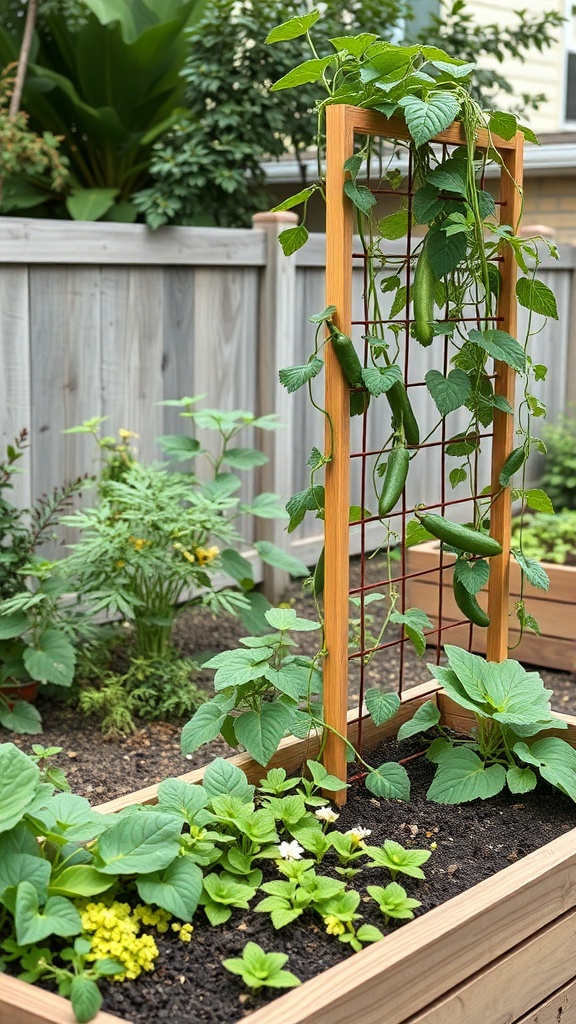
Vertical gardening is a fantastic way to maximize space in your raised garden beds. The image shows a charming setup where plants are climbing a wooden trellis. This method not only saves ground space but also adds visual interest to your garden.
In the image, you can see cucumbers growing vertically, which helps them get plenty of sunlight. This technique is perfect for small areas, allowing you to grow more plants without crowding them. The trellis supports the plants while keeping them off the ground, reducing the risk of pests and diseases.
Below the trellis, other plants like leafy greens and flowers thrive. This layering creates a beautiful and productive garden. You can mix different types of plants, which can help with pest control and improve growth. Vertical gardening is not just practical; it can also turn your garden into a stunning display.
Layering Plants for Aesthetic Appeal
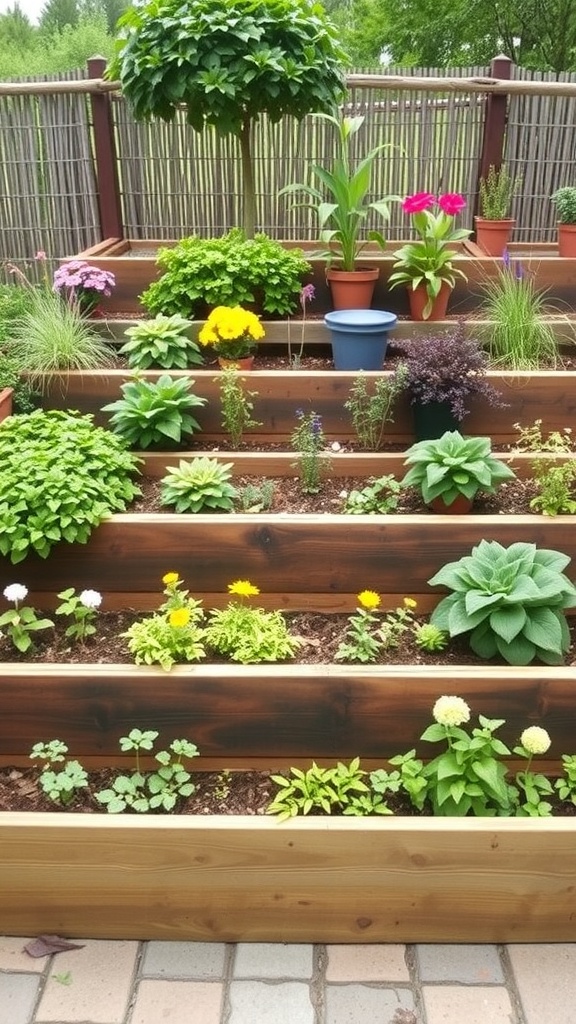
Creating a beautiful raised garden bed is all about layering plants effectively. The image shows a well-designed layout with various plants arranged in tiers. This not only maximizes space but also adds depth and visual interest.
In the foreground, you can see vibrant flowers like marigolds and daisies. Their bright colors catch the eye and create a cheerful atmosphere. Behind them, lush green plants provide a nice contrast, making the flowers pop even more.
The use of different heights is key here. Taller plants, like the ones in pots at the back, draw the eye upward. This layering technique makes the garden feel more dynamic and inviting. It’s a great way to showcase a variety of plants while ensuring each one gets the attention it deserves.
Don’t forget about texture! Mixing leafy greens with flowering plants creates a rich tapestry of colors and shapes. This not only enhances the aesthetic appeal but also attracts beneficial insects to your garden.
Overall, this layout demonstrates how thoughtful plant selection and arrangement can transform a simple garden bed into a stunning focal point.
Designing for Accessibility
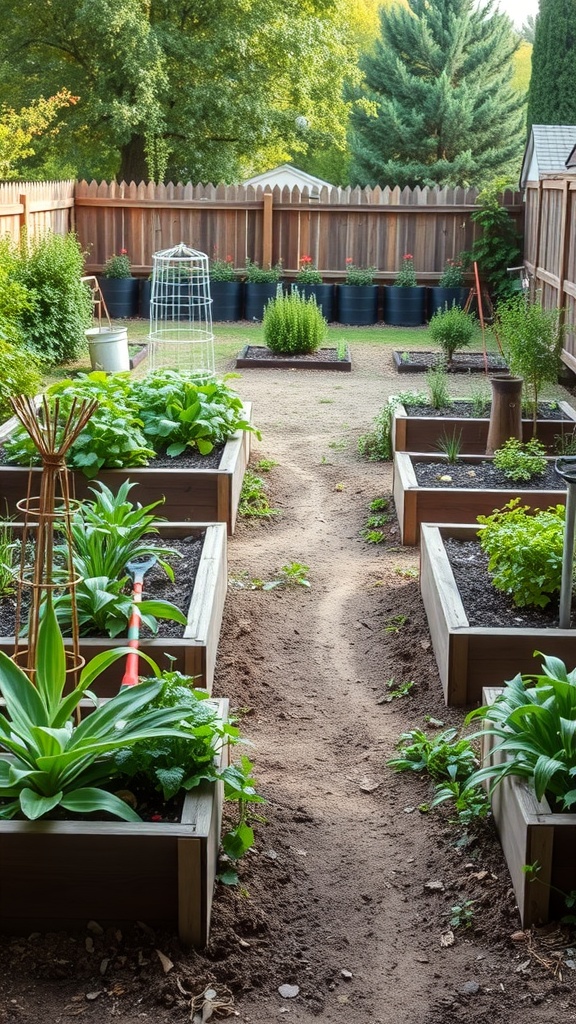
Creating a raised garden bed layout is not just about aesthetics; it’s also about making gardening accessible for everyone. The image shows a well-organized garden with raised beds and clear pathways, making it easy for anyone to navigate.
The layout features wide paths between the beds. This design allows for easy access, whether you’re using a wheelchair or simply want to stroll through the garden. It’s important to keep these paths clear and wide enough to accommodate various mobility needs.
Notice how the raised beds are at a comfortable height. This design choice means that bending down is minimized, making it easier for people of all ages to tend to their plants. Adding features like trellises can also enhance accessibility, allowing for vertical gardening without taking up too much space.
Incorporating a variety of plants at different heights can create visual interest while also being functional. This layout not only looks great but ensures that everyone can enjoy the benefits of gardening.
Enhancing Soil Quality with Bed Depth
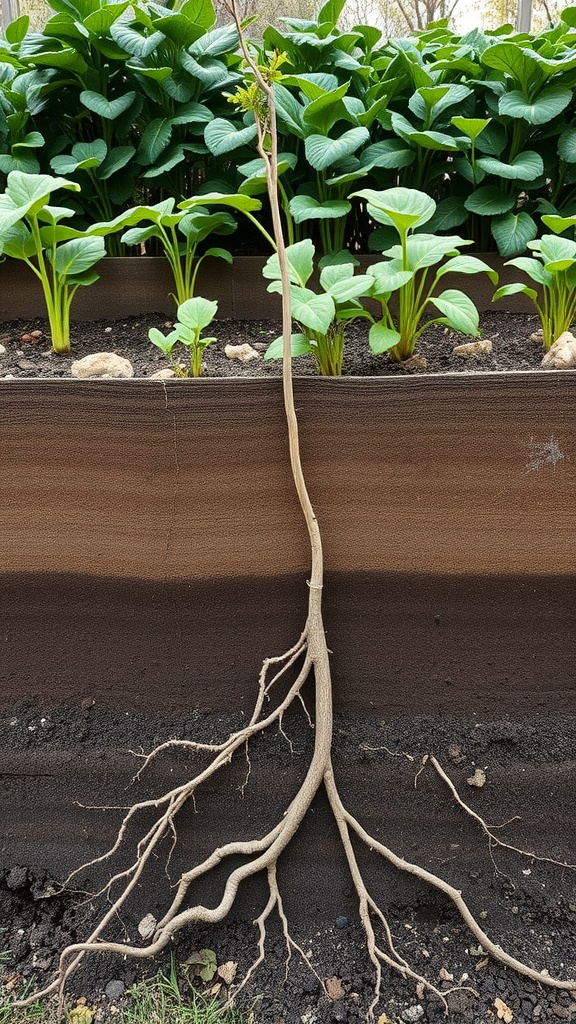
When it comes to raised garden beds, depth plays a key role in soil quality. The image shows a healthy root system thriving in rich soil, which is essential for plant growth. A deeper bed allows roots to spread out, accessing more nutrients and water.
In the picture, you can see the contrast between the soil layers and the vibrant green leaves above. This visual highlights how deep soil can support robust plant life. The roots are reaching down into the dark, nutrient-rich soil, showing how depth can enhance overall health.
Choosing the right depth for your raised beds can lead to better drainage and aeration. This is important for preventing root rot and promoting healthy growth. So, when planning your garden layout, keep in mind that deeper beds can make a significant difference in soil quality and plant vitality.
Creating a Theme for Your Garden
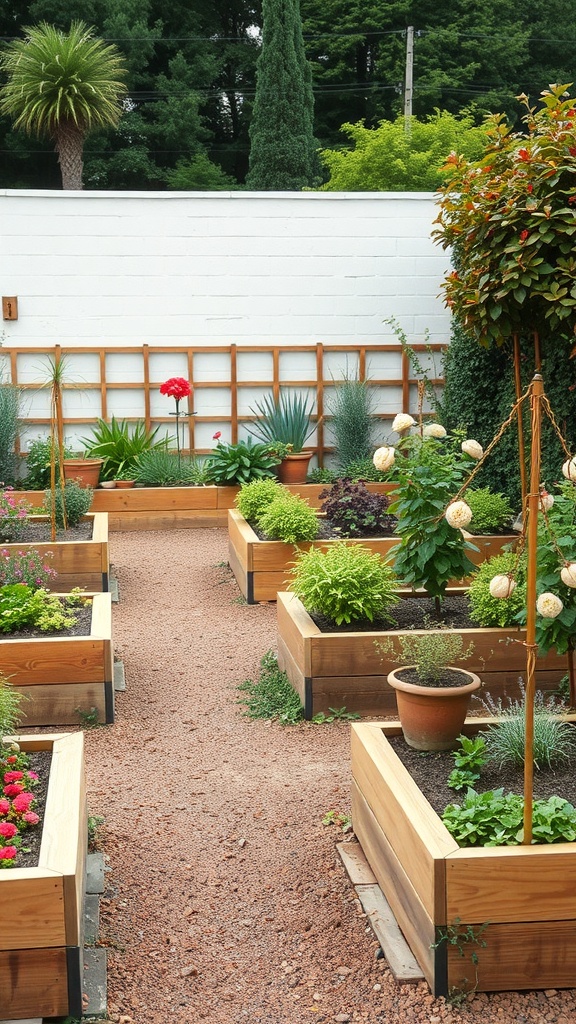
When setting up raised garden beds, think about the theme you want to create. The image shows a beautiful layout with wooden beds that invite you to explore. Each bed is filled with a variety of plants, showcasing different colors and textures.
Consider using a color scheme that matches your home or the surrounding landscape. The vibrant greens and pops of color in the flowers create a lively atmosphere. You can mix herbs, vegetables, and flowers to add both beauty and functionality to your garden.
Pathways between the beds, like the gravel path in the image, help guide visitors through your garden. This layout not only looks nice but makes it easy to tend to your plants. Think about how you want people to move through your space.
Incorporating decorative elements, such as trellises or pots, can enhance your theme. The plants in the image are complemented by the simple yet elegant structures around them. Choose features that resonate with your personal style.
Watering System Design
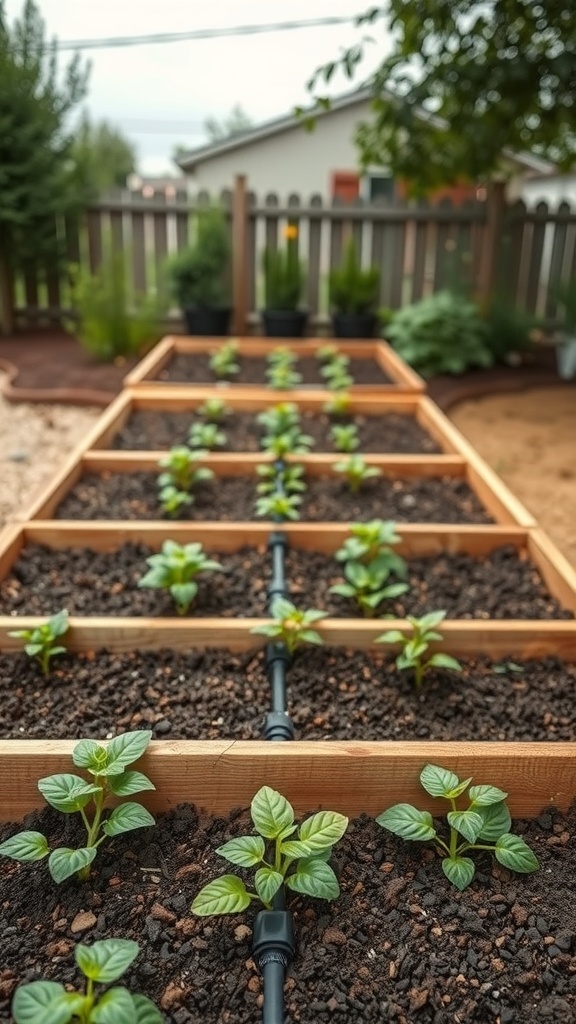
In the image, we see a well-organized raised garden bed layout. The rows of young plants are neatly arranged, and a drip irrigation system runs along the soil. This setup is perfect for ensuring that each plant receives the right amount of water without waste.
When designing a watering system for your raised garden beds, consider using drip irrigation. This method delivers water directly to the roots, promoting healthy growth while conserving water. The black tubing seen in the image is a key component of this system, allowing for efficient watering.
Another option is to install a soaker hose, which can be laid out in the garden bed. This allows water to seep slowly into the soil, keeping it consistently moist. Whichever method you choose, make sure to monitor the moisture levels in the soil to avoid overwatering or underwatering your plants.
Using Recycled Materials for Beds
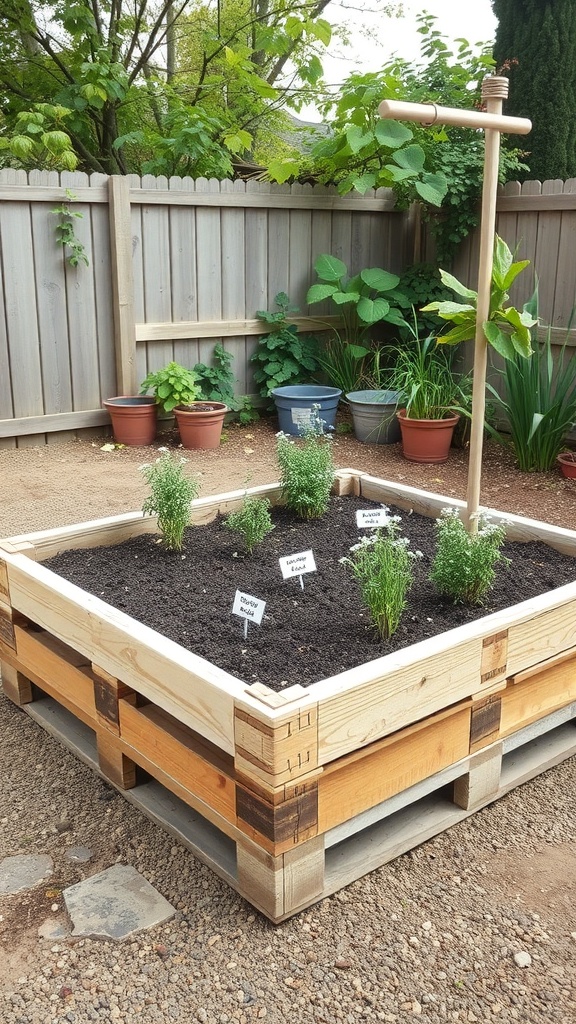
Creating raised garden beds from recycled materials is a fun and eco-friendly way to enhance your garden. The image shows a well-constructed raised bed made from wooden pallets. This design not only looks great but also makes use of materials that might otherwise go to waste.
Using pallets is a smart choice. They are sturdy and can be easily assembled into various shapes and sizes. The natural wood adds a rustic charm to your garden. You can paint or stain the wood to match your style, or leave it as is for a more natural look.
In the image, you can see herbs planted in the bed, labeled for easy identification. This is a great way to keep your garden organized. Raised beds also provide better drainage and can help keep pests away from your plants.
Don’t forget to line the inside of the bed with landscape fabric to prevent weeds from growing through. This simple step can save you a lot of time and effort in maintenance. Overall, using recycled materials like pallets for your raised garden beds is a practical and creative way to garden sustainably.
Building Multi-Level Raised Beds
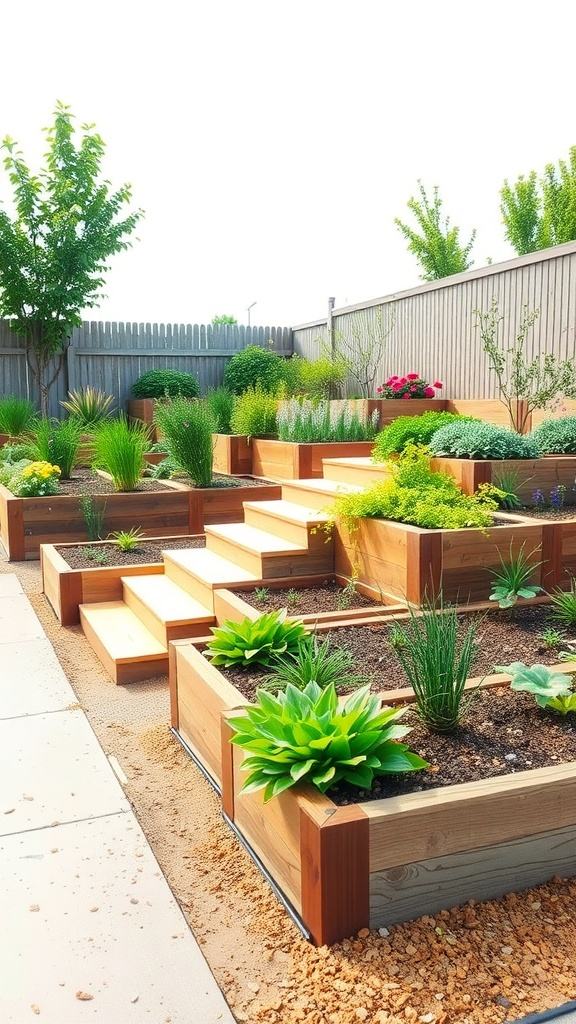
Multi-level raised beds are a fantastic way to maximize space and create a visually appealing garden. The image shows a beautifully designed layout with several tiers, each filled with vibrant plants and flowers. This setup not only adds depth to your garden but also makes it easier to tend to your plants.
The steps connecting the levels make access simple. You can easily reach your herbs and vegetables without bending over too much. This design is perfect for those who want to enjoy gardening without the strain on their backs.
Incorporating different plants at various heights allows for better sunlight exposure and air circulation. You can mix herbs, vegetables, and flowers for a colorful and functional garden. Plus, the wooden frames give a rustic charm that enhances any outdoor space.
Consider your local climate and choose plants that thrive in your area. With a little planning, your multi-level raised beds can become a stunning focal point in your yard.
Incorporating Pathways for Easy Access
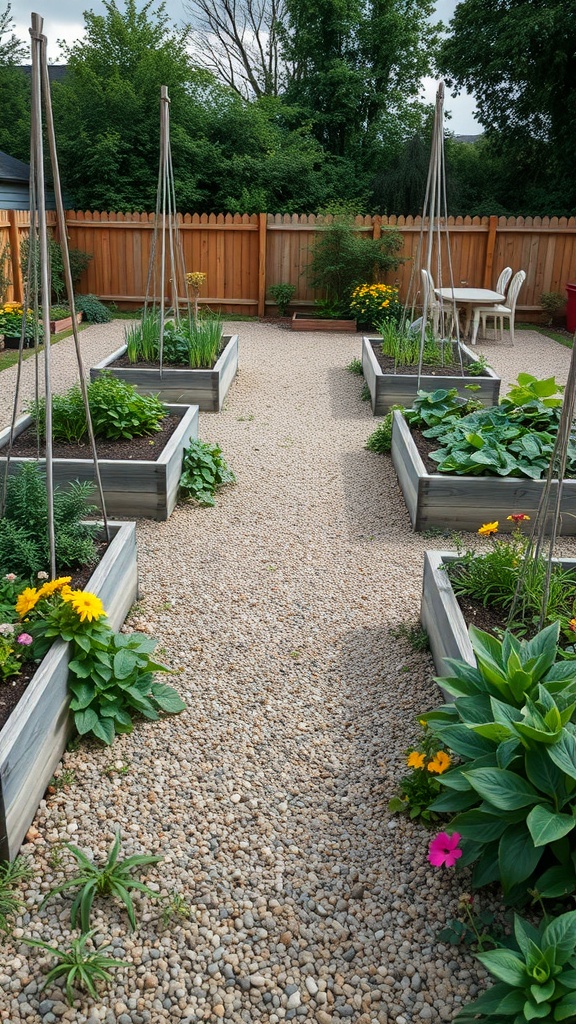
Pathways are a key part of any raised garden bed layout. They make it easy to navigate through your garden without stepping on the soil. This helps keep your plants healthy and your garden looking neat.
The image shows a lovely garden with gravel pathways between raised beds. These paths allow for easy access to each bed, making it simple to tend to your plants. You can see how the pathways create a clear route, inviting you to explore and enjoy the garden.
Using materials like gravel or wood chips for pathways can also enhance the overall look of your garden. They add texture and contrast to the greenery of the plants. Plus, they help with drainage, preventing muddy spots after rain.
When designing your garden, think about the width of your pathways. They should be wide enough for you to walk comfortably and carry tools. A good rule of thumb is to make them at least 2 feet wide. This way, you can easily access your plants without feeling cramped.
Incorporating a Compost Area

In the image, we see a lovely layout of raised garden beds, each neatly organized and ready for planting. The green compost bin stands out, indicating a dedicated space for composting. This is a fantastic addition to any garden design.
Having a compost area nearby is a smart way to recycle kitchen scraps and yard waste. It enriches the soil, making your plants healthier and more productive. The compost bin in the image is easily accessible, which is key for regular maintenance.
When planning your garden, think about placing the compost area close to your raised beds. This makes it easy to add compost to your soil. You can also use wooden stakes to label your plants, as seen in the image, which helps keep things organized.
Incorporating a compost area not only benefits your plants but also reduces waste. It’s a simple step that can make a big difference in your gardening experience. Plus, it’s rewarding to see your scraps turn into nutrient-rich compost!
Seasonal Rotation Planning
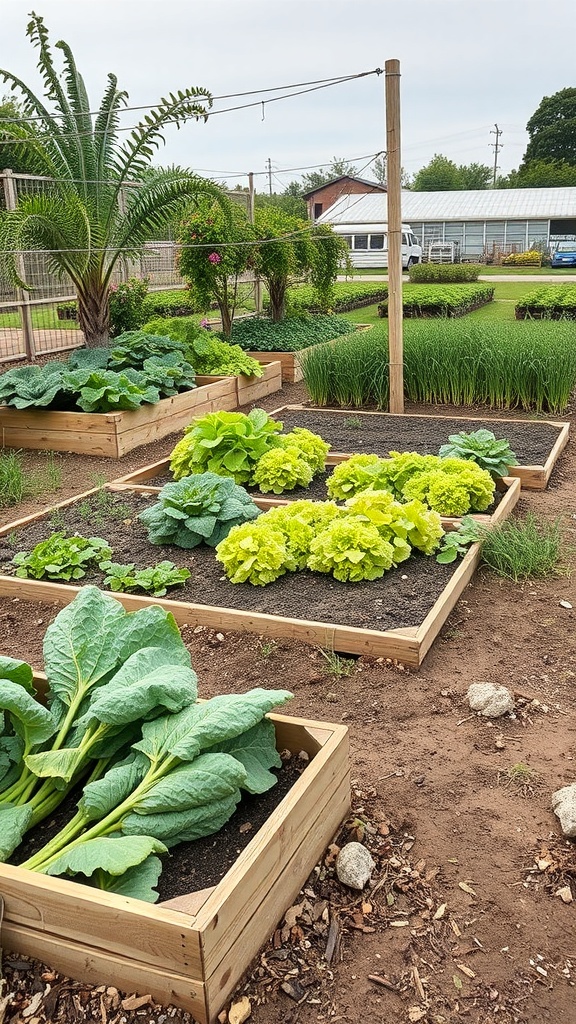
Planning your raised garden beds for seasonal rotation is key to a thriving garden. The image shows vibrant lettuce and leafy greens in well-defined beds, highlighting the potential for a productive layout. Each bed can host different crops throughout the year, ensuring soil health and variety.
When you rotate crops, you prevent pests and diseases from settling in. For instance, after harvesting lettuce, you might plant beans in that bed. This not only keeps the soil nutrients balanced but also maximizes your space. The raised beds in the image are perfect for this practice, allowing easy access for planting and maintenance.
Consider the seasons when planning. Cool-season crops like lettuce thrive in spring and fall, while warm-season plants like tomatoes love summer. By observing the garden’s layout, you can visualize which crops will follow others, creating a cycle that benefits your garden.
Planning for Seasonal Changes
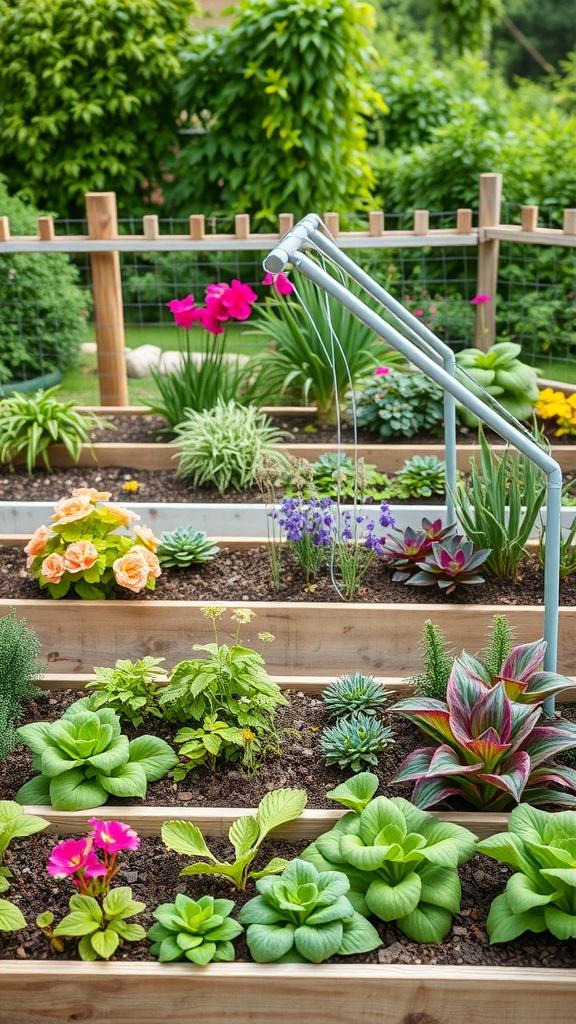
When designing raised garden beds, think about how your plants will change with the seasons. The image shows a vibrant layout with various plants, showcasing how different colors and textures can create a lively space.
In spring, you might want to plant bright flowers like the pink ones seen here. They add a cheerful touch as everything begins to bloom. As summer rolls in, leafy greens and herbs can thrive in the warm weather, providing fresh ingredients for your kitchen.
As the seasons shift, consider rotating your crops. This not only keeps your garden healthy but also allows you to enjoy different flavors throughout the year. The layout in the image suggests a mix of flowers and vegetables, making it easy to adapt to seasonal changes.
Finally, don’t forget about winter! Some plants can survive the cold, while others may need protection. Planning for these changes ensures your garden remains beautiful and productive year-round.
Incorporating Wildlife Features
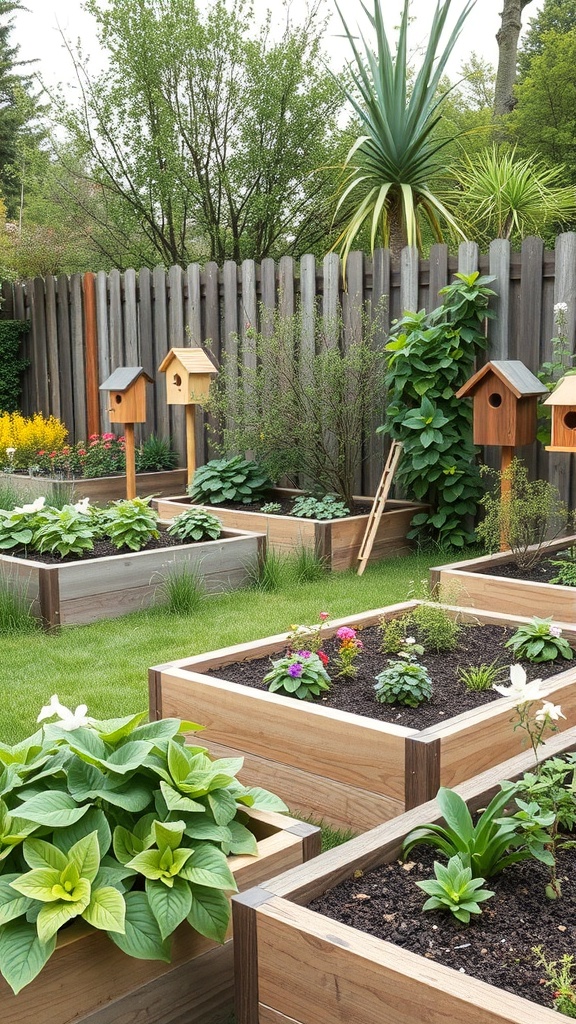
Creating a raised garden bed layout is not just about growing plants; it’s also about inviting wildlife into your space. The image shows a lovely garden with raised beds, surrounded by greenery and charming birdhouses. These features can turn your garden into a lively ecosystem.
Birdhouses, like the ones seen here, are a great addition. They provide shelter for birds, which can help control pests in your garden. Plus, watching birds flit around adds a joyful touch to your gardening experience.
Consider planting flowers that attract pollinators, such as bees and butterflies. The vibrant blooms in the image suggest a mix of flowers that can draw these beneficial creatures. A diverse plant selection not only beautifies your garden but also supports local wildlife.
Don’t forget about the ground cover! The lush greenery around the beds offers habitat for small critters. Incorporating native plants can enhance this effect, making your garden a welcoming spot for local fauna.
Utilizing Shade Structures
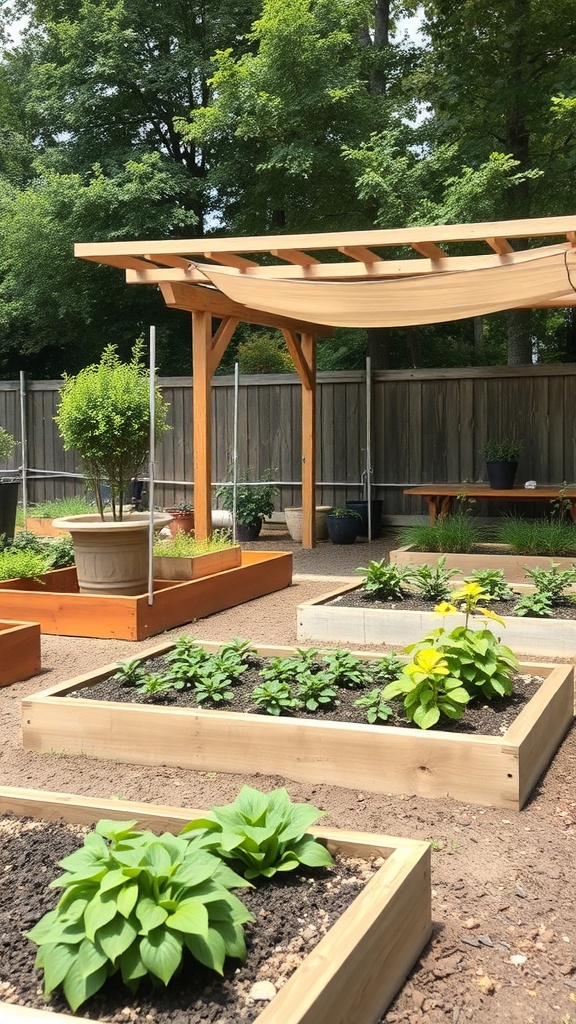
Shade structures can be a game changer for your raised garden beds. In the image, you can see a lovely setup with a wooden pergola providing shade over the garden area. This not only protects plants from harsh sunlight but also creates a comfortable space for gardeners to relax and tend to their plants.
When planning your garden layout, think about where the sun hits at different times of the day. Placing shade structures strategically can help keep delicate plants from wilting in the heat. The pergola in the image allows for some sunlight to filter through while still offering protection.
Incorporating shade can also extend your growing season. Some plants thrive better in partial shade, making it easier to grow a variety of crops. Consider using fabric or lattice for additional shade options, which can be adjusted based on the season.
Overall, a well-placed shade structure can enhance your gardening experience, making it more enjoyable and productive. So, don’t overlook this important aspect when designing your raised garden beds!
Adding Decorative Elements
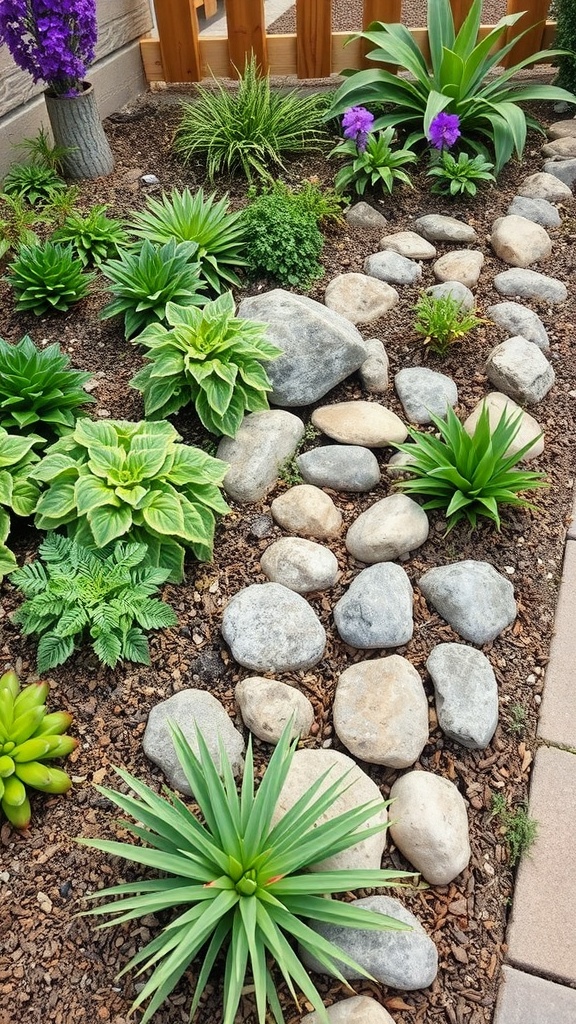
When designing raised garden beds, adding decorative elements can truly enhance the space. The image showcases a lovely arrangement of plants and decorative features that create a welcoming vibe. Notice how the soft textures of the grasses and the vibrant greens of the plants add life to the area.
The stone border is not just functional; it also adds a rustic charm. It helps define the garden bed while complementing the natural elements around it. Decorative stones and pebbles can be used creatively to guide the eye and create pathways.
Incorporating statues or garden ornaments, like the charming figure seen in the image, can serve as focal points. They bring personality to the garden and can reflect your style. Mixing different heights and textures makes the garden visually interesting and inviting.
Lastly, consider using varied plant heights and colors to create layers. This adds depth and richness to your garden bed. With thoughtful decoration, your raised garden beds can become a beautiful extension of your home.
Creating a Family-Friendly Garden

Raised garden beds are a fantastic way to create a family-friendly garden. The image shows a vibrant garden space filled with wooden raised beds, each brimming with various plants. This layout not only looks inviting but also encourages kids to get involved in gardening.
The design features a child happily tending to the plants, highlighting how gardening can be a fun family activity. The colorful pots and playful decorations, like the green lamp and white bird statue, add a whimsical touch, making the space feel lively and engaging.
Raised beds are easier for children to reach, allowing them to plant, water, and harvest their own veggies and flowers. This hands-on experience teaches them about nature and responsibility. Plus, it’s a great way to bond as a family while enjoying the outdoors.
The gravel pathways between the beds ensure safety and accessibility, making it easy for everyone to move around. Incorporating a chalkboard for notes or drawings adds an educational element, inviting creativity and learning.
Integrating Garden Furniture
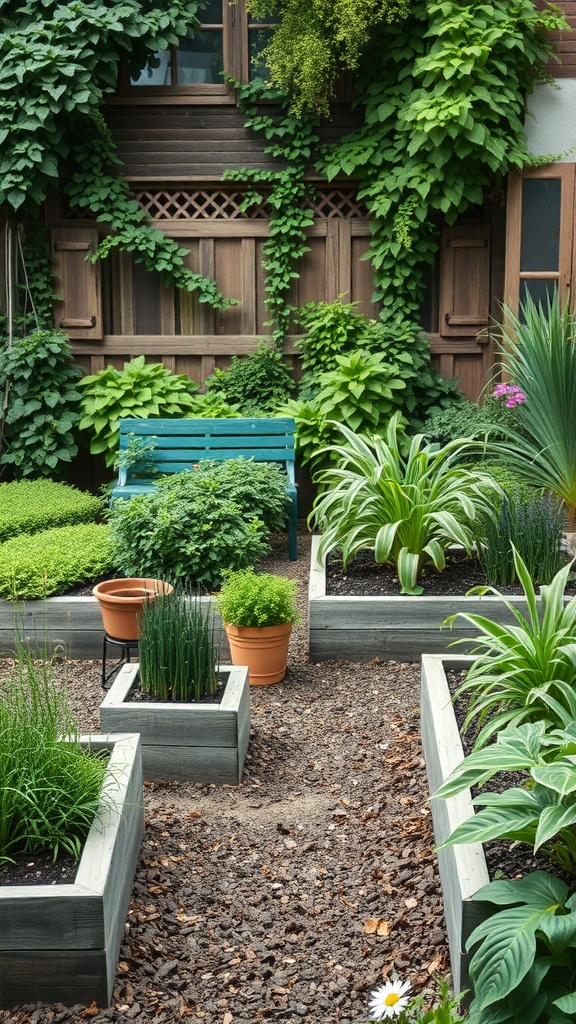
When planning your raised garden beds, don’t forget about the furniture! A cozy bench or a few chairs can transform your garden into a relaxing retreat. In the image, a charming blue bench stands out against the lush greenery, inviting you to sit and enjoy the view.
Placing furniture near your garden beds makes it easy to take breaks while tending to your plants. You can sip tea or read a book, surrounded by the beauty of your hard work. The layout shown here balances functionality and aesthetics, making the space feel welcoming.
Consider adding small tables for tools or snacks. Terracotta pots add a nice touch and can hold herbs or flowers, enhancing the overall look. This combination of plants and furniture creates a harmonious space where you can unwind and connect with nature.
